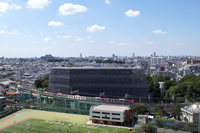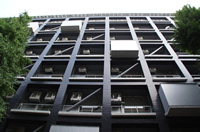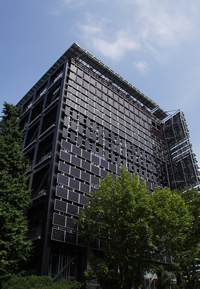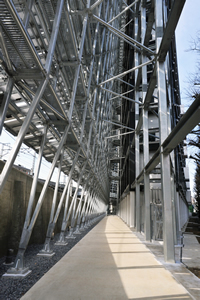Tokyo Institute of Technology's new Environmental Energy Innovation building (EEI) is one of a kind. It employs advanced technologies to attain a high degree of electricity self-sufficiency, and these technologies have been very cleverly integrated into the building’s design and structure. As a result, it not only achieves its goal of being a center for conducting interdisciplinary leading-edge research in energy, the environment and urban development, but the building itself is a showcase for these fields of study.
“People tend to focus on the building’s 4,570 solar panels that generate 650 kilowatts of power,” says associate professor Manabu Ihara, who specializes in fuel cells, solar cells and energy system. “But there is much more at work helping to provide energy and reduce waste, as well as cutting carbon dioxide emissions by 60 percent.” One example he points to is a fuel cell system that generates 100 kilowatts of electricity to heat water, and which also makes use of its own waste heat to provide air conditioning in the summer and winter.
Professor of Architectural Design, Yoshiharu Tsukamoto, emphasizes how the center’s different kinds of solar panels are not just tacked on, as is the case with many buildings, but are woven into the building’s design. “The panels are an architectural element in themselves and form one continuous integrated ‘solar envelope’ around the building,” he says. “And because solar technology is changing rapidly, each panel can be easily replaced once the technology has advanced sufficiently.”
The steel frame holding the panels is connected to the building in a way that provides space in between, allowing light in and enabling the air to circulate. Rows of louver and perpendicular panels alternate across the face of the building, according to whether the floors behind them are used for office work that requires natural light, or for lab experiments which do not.
As for the building's structure, Toru Takeuchi, professor of Architectural Engineering, describes how a frame of diagonal braces hugging the building's perimeter is used for dissipating the seismic energy of earthquakes both large and small. They are made of steel casings with ductile steel cores designed to yield during tension and pressure.
"These buckling restrained braces not only help protect the building from tremors, they also enable the structure of the main building to do without internal walls," says Takeuchi. “This makes it easier for different researchers to mix and communicate with each other, which is a key feature of the building.”

The Environmental Energy Innovation building located in Tokyo Institute of Technology, Ookayama Campus.

Diagonal braces, viewable from the north side of the building.
. Any information published on this site will be valid in relation to Science Tokyo.






